Definition: Cyanobacteria represents the major group of photosynthetic bacteria, which can carry out the oxygenic photosynthesis. It releases oxygen and uses water as an electron-donating substrate, i.e. splits water molecule to release oxygen. Other than this, they are also capable of fixing nitrogen.
Classification of Cyanobacteria
Kingdom: Monera
Division: Eubacteria
Class: Cyanobacteria
Examples: Nostoc sp., Oscillotoria sp., Spirulina sp., Lyngbya sp., Azolla sp., Anaebina sp., Gleotrichia sp. etc.
Cyanobacteria are the aquatic organisms, and they contain chloroplast to carry out photosynthesis. These are closely related to the group of bacteria, but it possesses one feature similar to the eukaryotes algae, i.e. the presence of chloroplast. Majority of the cyanobacteria are free-living and some acts like endosymbionts.
Here in this content, we will discuss the discoveries led to the origination of cyanobacteria along with its characteristics, habitat, types, structure and reproduction. Also, we will talk over the positive and negative ecological impacts of the cyanobacteria.
Content: Cyanobacteria
- History
- Characteristics
- Types
- Structure
- Specialised Structure
- Reproduction
- Economic Importance
- Harmful Effects
History of Cyanobacteria
Cyanobacteria were the first algae to appear as a fossil in the history of 3.5 billion years. Fossils of cyanobacteria were called as “Stromatolites“. These were the first organism responsible for releasing oxygen into the environment through their photosynthetic activities. Among prokaryotic organisms, cyanobacteria were the first organisms to use two photo-systems, both I and II.
Firstly, it showed resemblance to the algae group, by which it then included in the class Myxomycetes. But, after further study on their structure and characteristics, it is then placed in the group of Bacteria under the class Schizomycetes or cyanobacteria.
Characteristics of Cyanobacteria
Cyanobacteria are the prokaryotic and gram-negative bacteria. These are aerobic and photoautotrophic organisms. Its size ranges from 1-10µm. It contains a primitive nucleus. Membrane-bound organelles are absent in cyanobacteria. Chlorophyll a, phycocyanin and phycoerythrin are the photosynthetic pigments that are present in cyanobacteria.
- Chlorophyll a: Imparts green colour
- Phycocyanin: Imparts blue colour
- Phycoerythrin: Imparts red colour
Cyanobacteria are also called blue-green algae, due to the presence of chlorophyll a and phycocyanin. Chlorophylls are involved in the photosystem I, whereas phycocyanin pigments are associated with the photosystem II. Its photosynthesis is oxygenic, and they have the ability to fix atmospheric N2. The reserve food material is cyanophycean starch.
Habitat: These are the most genetically diverse organisms, which show a broad range of habitat. They can live in freshwater, marine water, damp places, moist soil, hot springs etc.
Types of Cyanobacteria
Depending upon the cell-type, the cyanobacteria can be of three kinds that are mentioned below:
- Unicellular: These are single-celled, having mucilage sheath covering.
Examples: Chroococcus sp. - Colonial: These are multicellular. It forms when the individual cells colonise themselves.
Examples: Gleocapsa sp. - Filamentous: These exist in the form of a chain with a mucilage sheath outside. It consists of:
Hetero-cysts: Helps in N2 fixation
Akinete: Collects the food material.
Examples: Nostoc sp., Oscillotoria sp. etc.
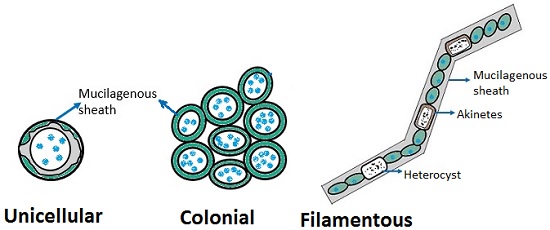
Structure of Cyanobacteria

The structural components of cyanobacteria are:
Sheath
It acts as an envelope of cyanobacteria. It is mucilaginous, undulating and hygroscopic in nature. Its physical and chemical properties depend upon the environmental conditions. It contains pectic substances. Its appearance is fibrillar under the microscope.
Function: Sheath protects the cell from the unfavourable conditions. It also keeps the cell moist.
Cell Wall
It is present between the sheath and the plasma membrane. The pores that are present on the cell wall helps in the secretion of mucilage. It consists of four layers (L-I, L-II, L-III and L-IV), connected through plasmodesmata.
L-I: It is the innermost layer, electron transparent and 3-10 nm thick.
L-II: It is thin and electron-dense. It is made of mucopeptide, mumaric acid, alanine, glucosamine, glutamic acid and diaminopametic acid. Its primary function is to provide shape and mechanical strength to the vegetative cell.
L-III: It is electron transparent, and 3-100 nm thick.
L-IV: It is the outermost layer of the cell wall that is electron-dense and wrinkled.
Plasma Membrane
It is a bilayer membrane, also called “Plasmalemma“. It is 70Å thick, selectively permeable membrane, which maintains the structural integrity of the cell. Lamellosomes are the structures formed after the fusion of lamellae by the invagination of the plasma membrane. It encloses the cytoplasm and other cell inclusions.
Cytoplasm
It consists of two regions:
Chromoplasm: It comprises of a vesicular structure called thylakoids, which are having a capacity of Photophosphorylation.
Centroplasm: It is colourless and regarded as the primitive nucleus (devoid of nuclear membrane and nucleolus). Some granular structures are present inside this.
Cytoplasmic inclusions: It includes the following bodies that are explained below.
- Cyanophycean granules: It is the nitrogenous reserve material. It is composed of equal molecules of arginine and aspartic acid. It constitutes about 8% of the total cell weight.
- Gas vacuoles: These are hollow, tough and elongated in shape. Its diameter is 75 nm and length is 200-1000 nm. Protein layer covers these gas vacuoles, which is 2nm thick. Its edges are conical.
- Carboxysomes: These are polyhedral bodies, which contain 1,5-ribulose biphosphate carboxylase.
- Phosphate bodies: These are the volutin granules.
- Phycobilisomes: It is a ball-like structure formed by the aggregation of phycobiliproteins. It is attached to the outer surface of the thylakoid.
- DNA matrix: Naked DNA fibrils are dispersed in the cytoplasm, and it lacks nucleoplasm. The base composition of DNA differs. Cyanobacteria contain covalently closed, non-functional, circular plasmid DNA.
Specialised Structure
Cyanobacteria possess a specialised structure known as Heterocyst.
Heterocyst: These are the modified vegetative cells. Its formation depends upon the nitrogen concentration in the environment. These appear pale yellow and slightly enlarged in size. Heterocysts form singly or in chains, and its position can be terminal or intercalary. It acts as a site of nitrogen fixation (converts N2 to NH3), under anaerobic conditions. They are mostly found in filamentous cyanobacteria like the members of Nostoc, Oscillotoria etc.
Functions of Heterocyst:
- Helps in N2– fixation
- Helps in vegetative reproduction
- It secretes enzymes that aid in growth and cell division of thallus.
Reproduction of Cyanobacteria
In cyanobacteria, reproduction occurs vegetatively and asexually.
Vegetative Reproduction
It involves the following methods
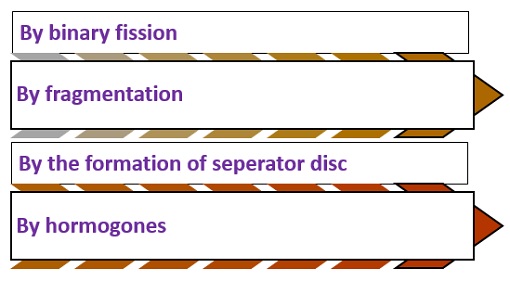
Binary fission: In this type, a constriction forms between the cells that lead to the cell enlargement and exchange of the chromosomal material. At last, the cell produces two identical daughter cells.

Fragmentation: During unfavourable conditions, thallus detaches to form a new thallus in the fragmentation method.
By the formation of separator disc: Sometimes gelatinous material occupies between the cell, which acts as a separator disc. This disc then separates the cell, which later produces new vegetative cells.
 By hormogones: Hormogones are the short fragments (5-10) found within the cell. It separates from the cell during the unfavourable condition, and the latter body glides and eventually develops into a new filamentous form.
By hormogones: Hormogones are the short fragments (5-10) found within the cell. It separates from the cell during the unfavourable condition, and the latter body glides and eventually develops into a new filamentous form.
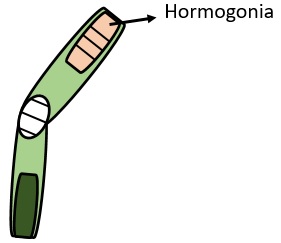
Asexual Reproduction
It includes the following methods:

By hormospores: Hormospores releases into the environment, as a result of cell lysis during the unfavourable conditions. Later, the spores germinate to produce new individuals as the favourable condition returns.
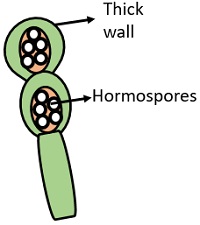
By akinetes: Akinetes develop in adverse conditions. Its size is larger than the vegetative cells, and they are surrounded by a thick wall. Akinetes separate from the vegetative cell and lives in a resting stage after the accumulation of enough food material within the cells. When favourable conditions return, it grows into a new individual.
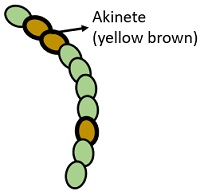
By heterocyst: It also forms in adverse conditions. On favourable conditions, these germinate into a new filament from either one or both the ends.

By endospore: Endospores are present inside the cell. It releases outside the cell as the cell ruptures during the unfavourable conditions. Later, the spores germinate into a new individual in the favourable conditions.

By exospore: Exospores are present outside the cell. In adverse conditions, it releases into the environment and germinates into a new individual on the favourable conditions.

Economic Importance
- Cyanobacteria improve the fertility of the soil.
- It prevents soil erosion.
- Cyanobacteria help in the reclamation of USAR soil.
- An acidic chemical that is synthesized naturally by the cyanobacteria reduces the soil alkalinity.
- Spirulina is an edible cyanobacterium, which produces SCPs (single-cell protein).
- Cyanobacteria colonise and add organic matter into the soil.
- Extract of Lyngbya is used in the manufacturing of the antibiotics.
- Cyanobacteria like Oscillotoria are used as “Pollution indicator”.
- Some cyanobacteria show symbiotic association with protozoa and fungi.
Harmful Effects
- When cyanobacteria present excess in water, it can lead to Water bloom.
- It depletes the amount of oxygen in the water and leads to the death of aquatic organisms.
- Cyanobacteria produce mucilage that produces a lousy odour as well as it degrades the water quality.
Thus, cyanobacteria represent a group of photosynthetic microorganisms that show a huge ecological and biological importance along with some harmful effects also.
Thank you for the article.
Thank you very much